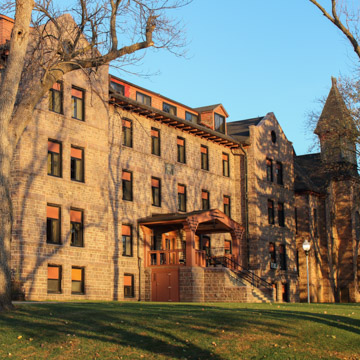Augustana University is located in south-central Sioux Falls. Three of the school’s oldest buildings are located along Summit Avenue on the northeast side of campus, sited upon a terrace landscaped that decreases in height from the northernmost structure to the southernmost. Founded in 1889 as the Lutheran Normal School, the campus was built on a four-acre site donated by prominent local businessmen. In 1918, Lutheran Normal School merged with Augustana College (originally Augustana Seminary and Academy, founded in 1860), which had moved to Canton, South Dakota, from Beloit, Iowa, in 1884. The new school then moved to Sioux Falls, where it became the largest private school in the state.
The Lutheran Normal School first occupied what is known as Old Main, built in 1889 and designed by local architect Joseph Schwarz. Like other Sioux Falls architecture, the three-story building is constructed of locally quarried Sioux quartzite. The rough-cut stone lends itself to the weight and massiveness of the structure; the Richardsonian Romanesque building features a square tower with pyramidal roof, hipped dormers, a broad roof plane, and round-arched and deeply recessed openings.
Immediately south of Old Main, Schwarz designed Ladies’ Hall in 1904–1905. The three-and-a-half-story dormitory with raised basement is also built of Sioux quartzite, but a darker variety than that of Old Main. A simplified version of the English Renaissance Revival style, the dormitory has projecting end bays with gabled parapet walls, and stringcourses divide each story. On the north end is a two-story crenellated structure that connects the dormitory to Old Main. The building was renamed East Hall in 1980.
The last of the three historic structures, the Administration Building, was constructed in 1919–1920, after the merger of the two institutions. Just south of East Hall, the building was designed by local architectural firm Perkins and McWayne and is a good example of the Tudor Gothic style. This three-story, brick building is trimmed in Bedford limestone. The center of the five bays is flanked by two angular towers with turrets; the main entrance is framed by a Tudor arch.
At the time the school was built, it was located about one-and-a-half miles from downtown Sioux Falls, and a half-mile from the nearest residential area. The area has since been built up and the campus is now just a short distance from the city’s major north-south thoroughfare. In 2015, the school became Augustana University.















